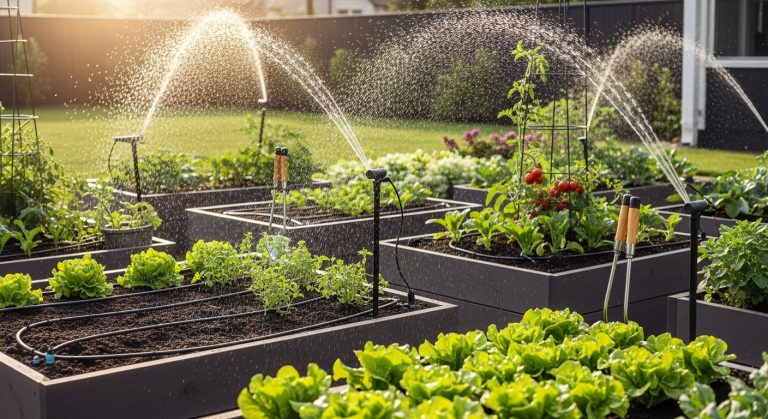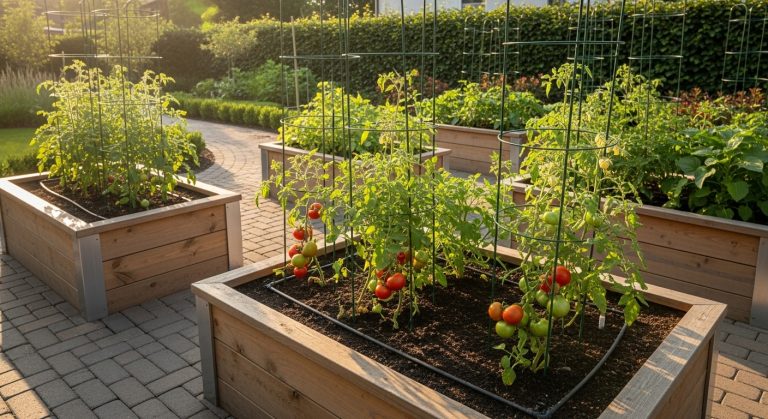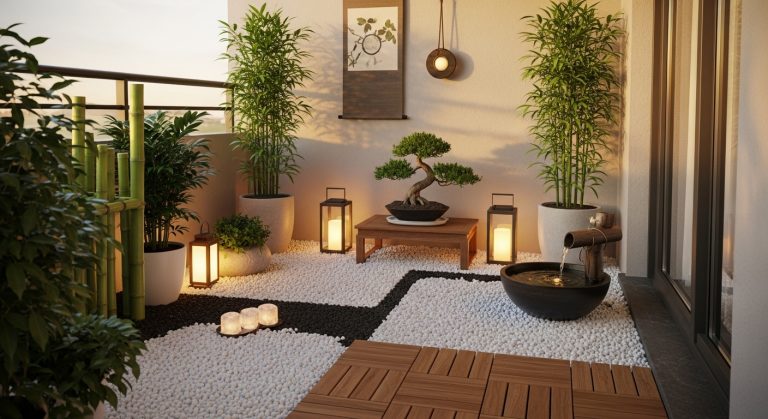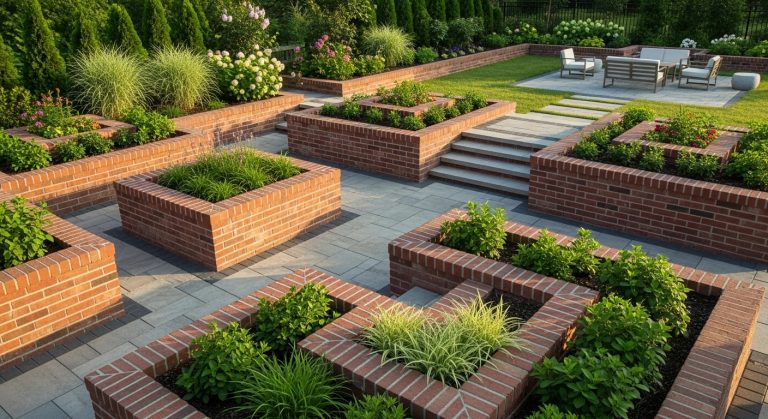English Garden Backyard Ideas: 15 Charming Ways to Bring Countryside Romance Home
There’s something about an English garden that feels like stepping into a living storybook — the gentle rustle of leaves, the scent of roses drifting through the air, and that perfect balance between structure and wildness. It’s not just landscaping; it’s atmosphere. It’s art that grows.
Whenever I walk through an English-style garden, I can’t help but slow down. There’s this unspoken invitation to pause, breathe, and just be. Maybe that’s why English garden backyard ideas have never gone out of style — they speak to something deeply human: our craving for beauty that feels effortless, natural, and timeless.
If you’ve been dreaming about turning your backyard into a little slice of the English countryside (no passport required), I’ve got you covered. Below are 15 detailed ideas that blend practicality with poetry — whether your yard is a cozy courtyard or a sprawling lawn, there’s something here to make it bloom with character.
1. Classic Cottage Garden Borders

Few things define an English garden backyard like overflowing flower borders packed with color and texture. Think roses, foxgloves, delphiniums, and lavender spilling gently onto winding paths.
Pros:
- Abundant charm: The layered, slightly unkempt look feels inviting and natural.
- Wildlife-friendly: Bees and butterflies can’t resist this mix of blooms.
- Low maintenance once established: Perennials return each year, stronger and fuller.
Cons:
- Needs planning: You’ll want plants that bloom in succession for season-long color.
- Can look messy: Without regular trimming, it might cross into “overgrown” territory.
Takeaway: Cottage-style borders are like nature’s confetti — joyful, abundant, and never the same twice.
2. Brick or Gravel Pathways
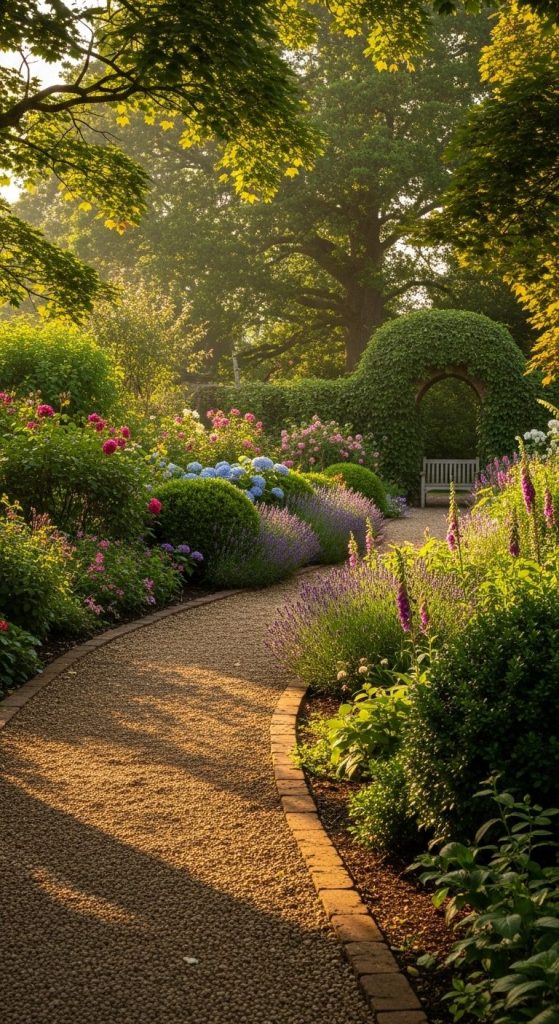
Every English garden has that satisfying crunch of gravel or the timeless look of worn brick underfoot. Pathways guide the eye (and the visitor) through your garden story.
Pros:
- Defines structure: Gives the garden a sense of rhythm and flow.
- Great drainage: Especially helpful in wetter climates.
- Adds instant character: Weathered materials look even better with age.
Cons:
- Weed control: Gravel paths need a good weed barrier or frequent upkeep.
Takeaway: A path isn’t just functional — it’s an experience. Walking through your garden should feel good.
3. Climbing Roses and Trellised Entrances
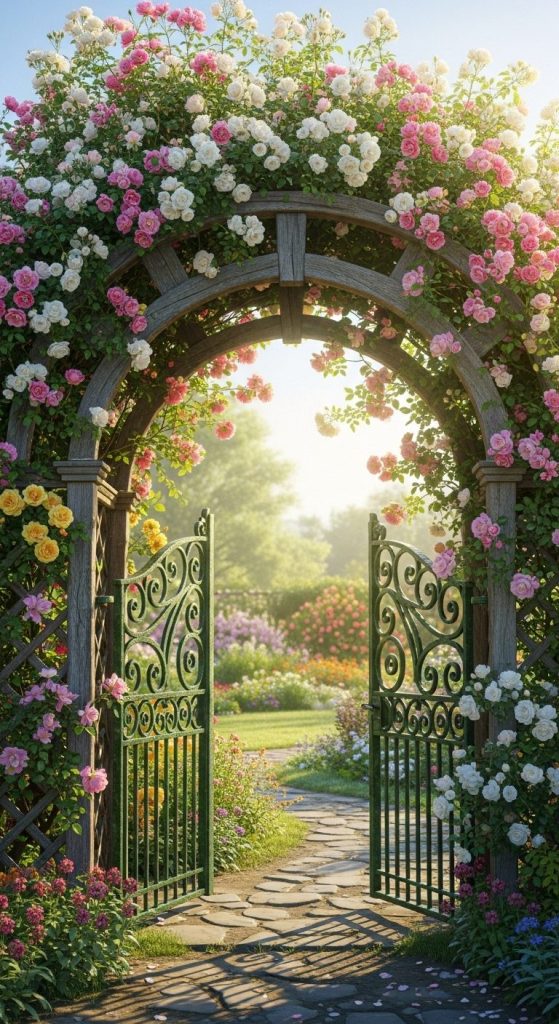
Nothing says “English romance” like roses climbing over an archway or trellis, framing your garden like the opening scene of a period drama.
Pros:
- Adds vertical interest: Draws the eye upward, adding dimension.
- Fragrance and color: Roses bring elegance and scent that lasts all summer.
- Creates “rooms”: Perfect for dividing large gardens into cozy zones.
Cons:
- Requires maintenance: Regular pruning and support are essential.
Takeaway: Trellised roses make any backyard feel like a Jane Austen novel — classic, poetic, and endlessly photogenic.
4. Central Lawn with Framing Borders
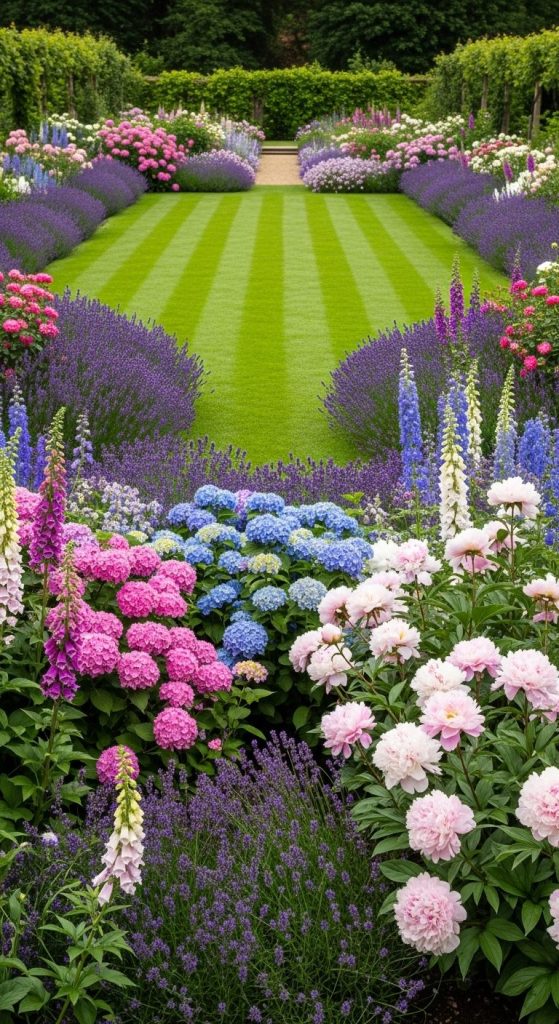
If your garden is small, simplicity is key. A neat green lawn framed by layered flower beds creates balance and breathing room amidst all the floral energy.
Pros:
- Clean structure: Keeps the wildness contained and harmonious.
- Easy to maintain visually: The lawn acts as a visual reset between plantings.
- Versatile: Works in both formal and casual garden styles.
Cons:
- Grass care: Requires mowing and edging to stay sharp.
Takeaway: A central lawn is the calm heart of an English garden — a peaceful pause surrounded by color and life.
5. Garden Benches and Iron Seating
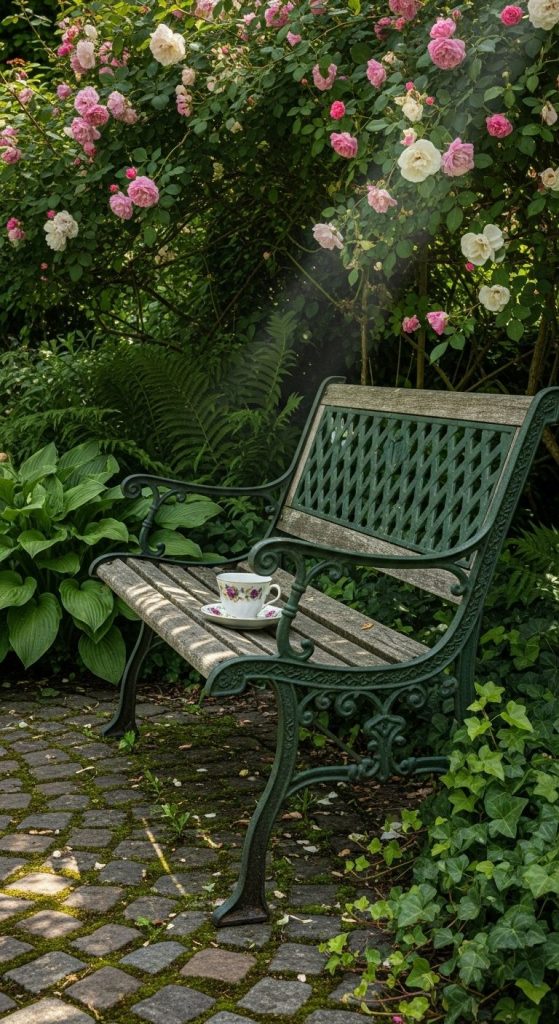
Every English garden needs a place to sit and admire the work — or to sip tea while pretending you’re in the Cotswolds.
Pros:
- Functional charm: Adds both comfort and a focal point.
- Durable materials: Cast iron or weathered wood fits the aesthetic perfectly.
- Encourages mindfulness: Great spots to read, rest, or reflect.
Cons:
- Weather exposure: Wooden benches need occasional sealing or paint touch-ups.
Takeaway: The right garden seat turns your yard into a story scene — where relaxation meets romance.
6. Boxwood Hedges and Garden Structure
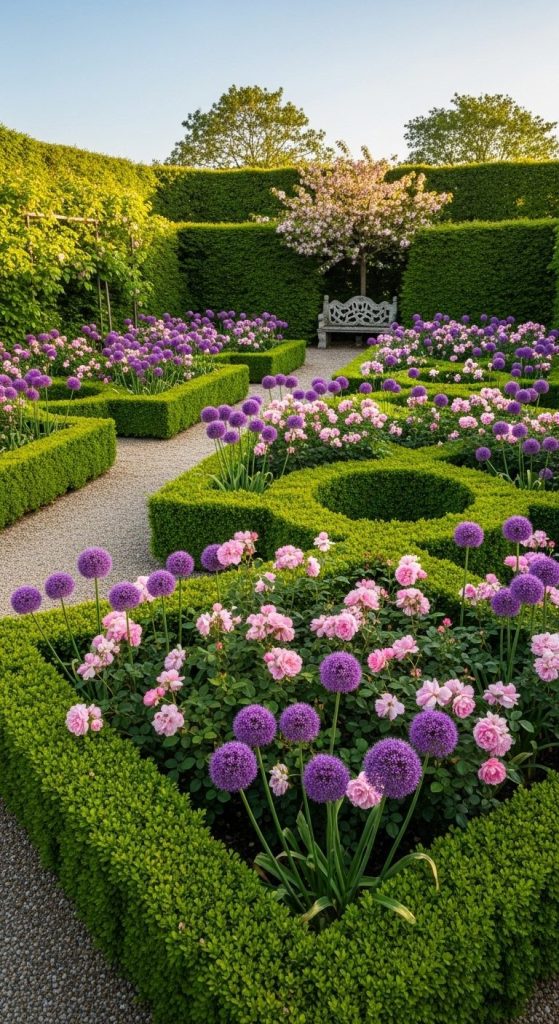
Order amidst chaos — that’s the English garden philosophy. Boxwood hedges bring structure to all that floral abundance.
Pros:
- Elegant geometry: Frames flower beds beautifully.
- Evergreen interest: Keeps the garden looking lively year-round.
- Customizable: Works as borders, labyrinths, or low dividers.
Cons:
- Prone to disease: Boxwood blight can be an issue in humid climates.
Takeaway: A little structure lets your creativity bloom freely — think of boxwood as the punctuation in your garden’s poetry.
7. Rustic Stone Walls and Edging

A low stone wall or edging instantly gives that old-world feel, especially when moss or creeping thyme grows between the cracks.
Pros:
- Timeless charm: Feels like it’s always been there.
- Practical: Defines borders and prevents soil erosion.
- Low maintenance: Natural stone only improves with age.
Cons:
- Labor-intensive: Building with stone takes time and effort.
Takeaway: A garden edged with stone feels rooted — literally and figuratively — in the landscape’s history.
8. Flowering Shrubs and Hedges
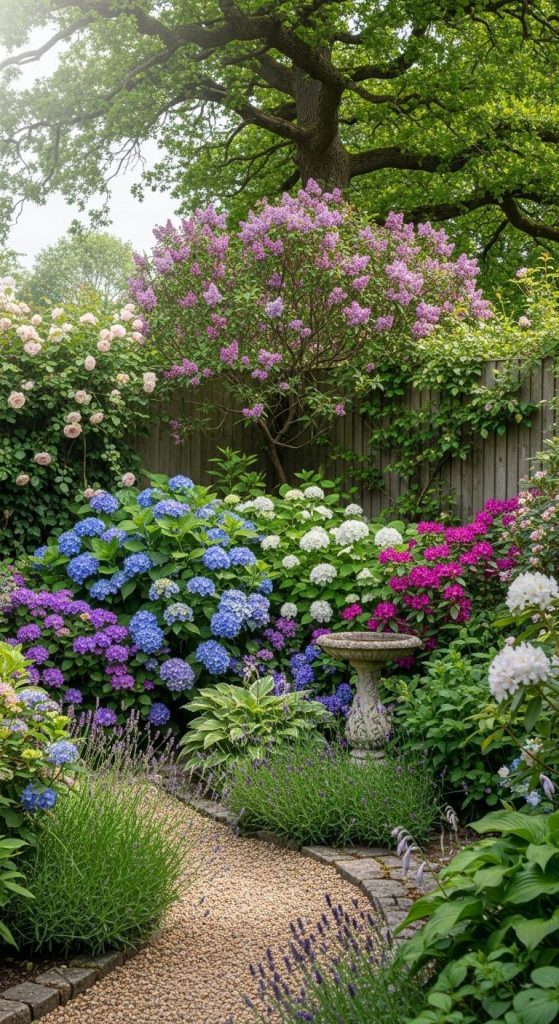
Shrubs like hydrangeas, lilacs, and spirea bring volume, texture, and long-lasting blooms to your backyard.
Pros:
- Low maintenance: Once established, shrubs need minimal care.
- Seasonal drama: Blossoms, foliage, and even winter silhouettes add depth.
- Privacy: Larger hedges double as natural screens.
Cons:
- Space requirement: Shrubs need room to spread — overcrowding looks messy.
Takeaway: Shrubs are the unsung heroes of the English garden — lush, reliable, and always camera-ready.
9. Garden Arbors and Pergolas
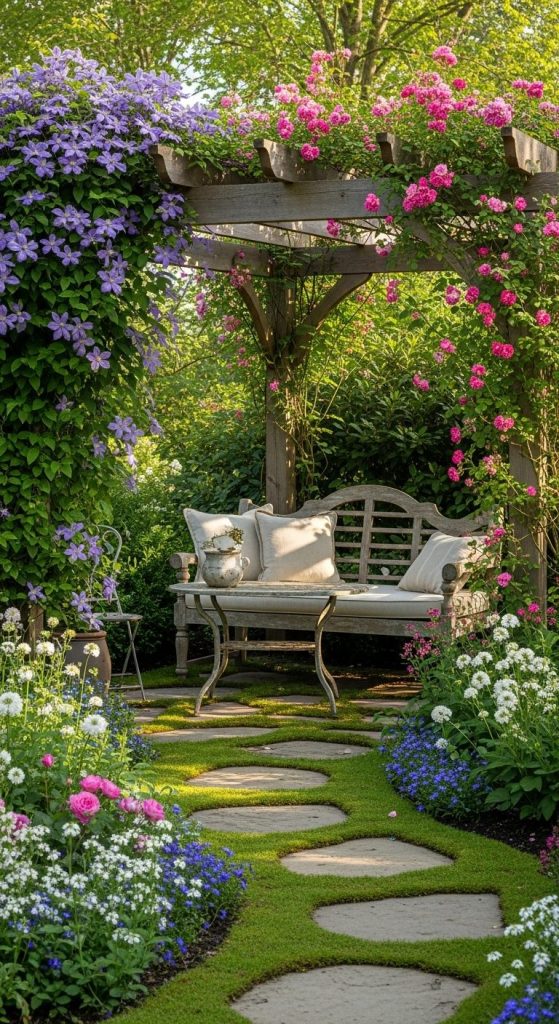
These elegant frames create structure while offering shade and space for climbing plants.
Pros:
- Adds height: Perfect for small gardens needing vertical balance.
- Supports vines: Clematis, honeysuckle, and roses thrive on them.
- Creates destination points: Visually draws guests deeper into your garden.
Cons:
- Installation cost: Wood or metal structures can be pricey.
Takeaway: A pergola isn’t just architecture — it’s a frame for nature’s art show.
10. Potted Gardens and Terracotta Charm
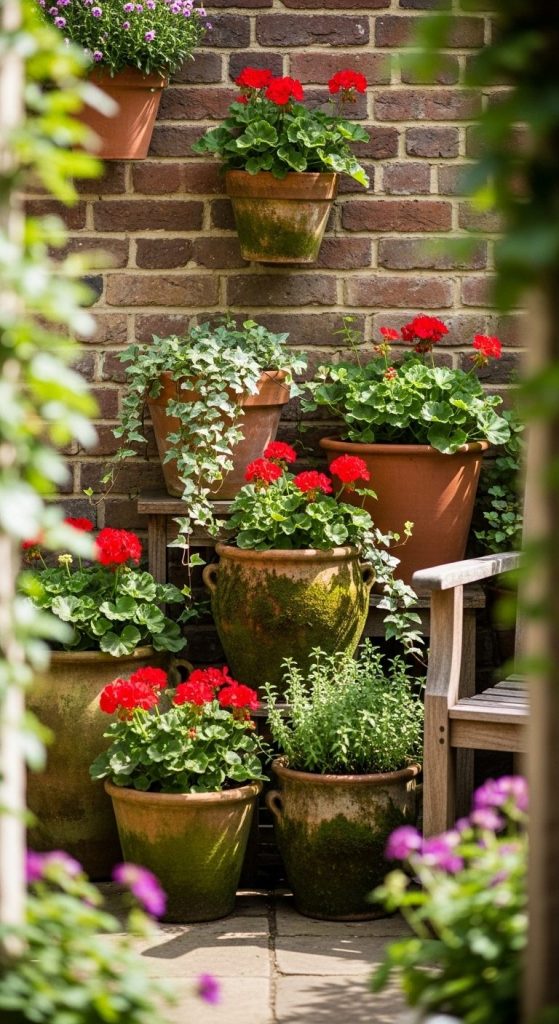
Terracotta pots bursting with geraniums, herbs, and trailing ivy are quintessentially English — charming, portable, and endlessly versatile.
Pros:
- Flexible design: Rearrange pots seasonally or for events.
- Great for patios or small spaces: No digging required.
- Classic texture: Terracotta adds warmth and authenticity.
Cons:
- Drying out: Pots need frequent watering in summer.
Takeaway: A few well-placed pots can turn any corner into a cottage dreamscape.
11. Herb and Kitchen Gardens

In true English tradition, beauty meets function. Herbs like rosemary, sage, and chives thrive alongside ornamental plants.
Pros:
- Practical and pretty: Fragrant and edible.
- Pollinator-friendly: Bees love flowering herbs.
- Compact: Works in raised beds or along borders.
Cons:
- Needs sunlight: Most herbs require full sun to flourish.
Takeaway: Nothing feels more luxurious than snipping herbs from your own English-style garden for dinner.
12. Garden Pond or Water Feature
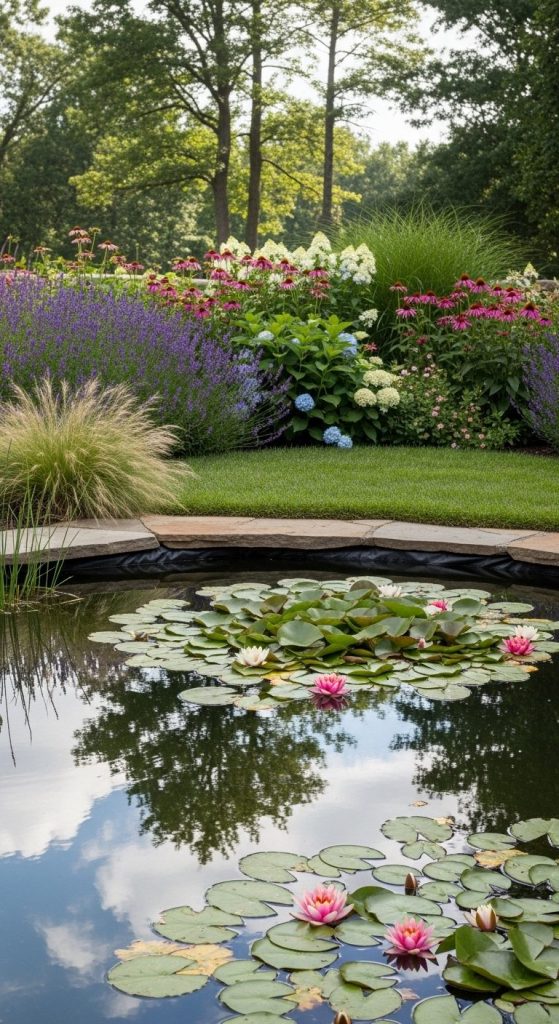
A gentle pond with water lilies or a burbling fountain adds serenity and old-world charm — like something you’d find in a countryside manor.
Pros:
- Calming sound: Running water transforms the mood instantly.
- Wildlife attraction: Birds, frogs, and dragonflies will visit.
- Visual balance: Water reflects sky and softens the garden’s density.
Cons:
- Maintenance: Needs regular cleaning and algae control.
Takeaway: A water feature makes your garden feel alive — literally and spiritually.
13. Wildflower Meadow Corners

You don’t need acres to embrace the wild English countryside. A small patch of native wildflowers adds vibrancy and biodiversity.
Pros:
- Eco-friendly: Supports pollinators and native species.
- Low maintenance: Once established, minimal watering or mowing.
- Natural aesthetic: Contrasts beautifully with formal elements.
Cons:
- Patience required: Meadows take a few seasons to mature fully.
Takeaway: A meadow corner is nature’s love letter — spontaneous, colorful, and full of life.
14. Greenhouse or Potting Shed

Every proper English garden has a greenhouse or a quaint potting shed tucked away behind the roses. It’s both functional and storybook-beautiful.
Pros:
- Extended growing season: Start seedlings early or overwinter delicate plants.
- Adds charm: Rustic wood or vintage glass instantly adds personality.
- Organized workspace: Keeps tools and supplies neat.
Cons:
- Space and cost: Not always practical for smaller gardens.
Takeaway: A greenhouse isn’t just a workspace — it’s a dreamer’s retreat.
15. Evening Lighting and Garden Glow
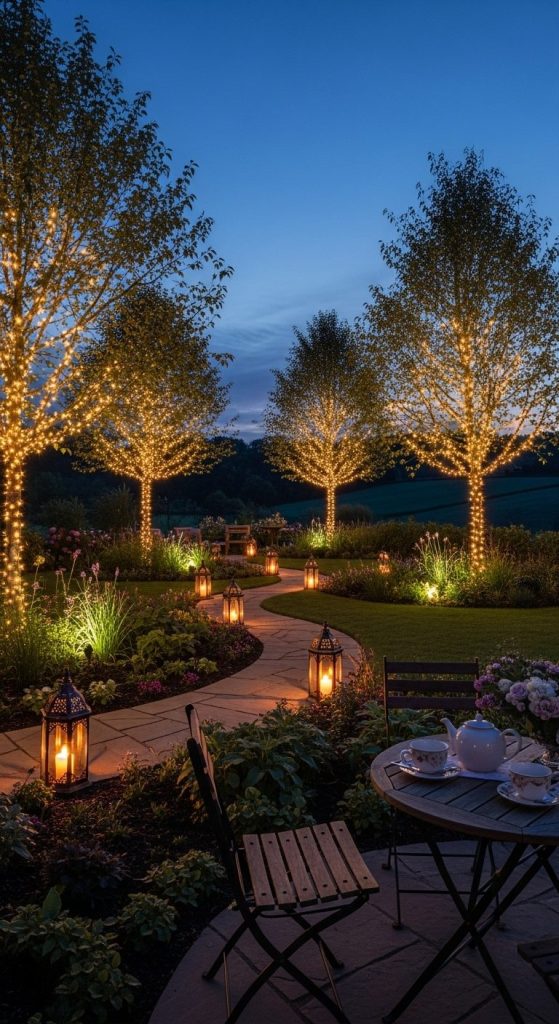
English gardens aren’t just for daytime. Subtle lighting — fairy lights, lanterns, or solar uplighting — brings the magic to life after sunset.
Pros:
- Extends enjoyment: Stay outside longer on warm evenings.
- Enhances atmosphere: Soft light highlights textures and paths.
- Safety: Illuminates walkways for nighttime strolls.
Cons:
- Initial setup: Outdoor wiring or solar placement takes planning.
Takeaway: When the sun sets, your garden shouldn’t disappear — let it shimmer like a midsummer night’s dream.
Conclusion: Your Backyard, Your Countryside Escape
At its heart, an English garden backyard isn’t about perfection — it’s about emotion. It’s the laughter over tea, the hum of bees, the soft petals brushing your hands as you pass.
Whether you start with a few terracotta pots or a full garden redesign, the key is creating a space that feels alive, layered, and deeply personal. These ideas aren’t rules — they’re invitations.
So go ahead — grab your gloves, pour a cup of Earl Grey, and start crafting your own slice of English paradise. IMO, there’s no better therapy than a garden that grows with you.

William Martin is a passionate bowler who spends most of his weekends playing the sport. With years of intense experience under his belt, William decided to share his knowledge by creating BOWLING OCEAN. Join me on this journey to explore the world of bowling and discover the tips and tricks to becoming a pro.

